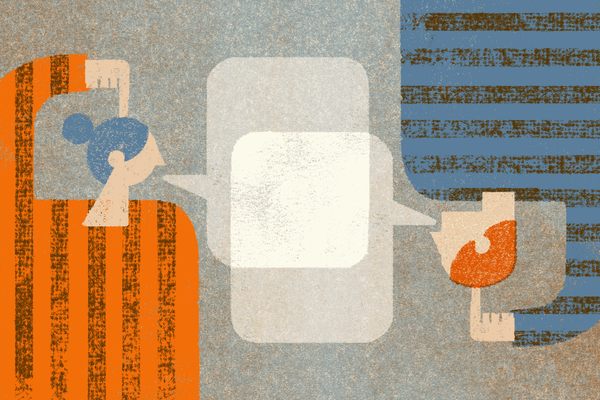Is There a Place in America Where People Speak With Neutral Accents?
Newscasters and Stephen Colbert seem to think the standard American accent exists.
Where in the U.S. is the accent most featureless? (Photo: Nadezda Murmakova/shutterstock.com)
If you want to anger a linguist, try bringing up a speech pattern called General American. “General American is a concept for which I’ve struggled to find a satisfying definition,” writes Ben Trawick-Smith of Dialect Blog. Dennis Preston, a dialectologist and sociolinguist at Oklahoma State University, goes even further. “General American doesn’t exist,” Preston says, “He was demoted to private or sergeant a long, long time ago.”
But the concept persists: we believe that, for example, newscasters, maybe some actors, and certainly some people, somewhere, speak an unaccented variety of American English. For instance, when Stephen Colbert explained his vocal patterns to 60 Minutes, he said:
“At a very young age, I decided I was not gonna have a Southern accent. Because people, when I was a kid watching TV, if you wanted to use a shorthand that someone was stupid, you gave the character a Southern accent. And that’s not true. Southern people are not stupid. But I didn’t wanna seem stupid. I wanted to seem smart. And so I thought, ‘Well, you can’t tell where newsmen are from.’”
The name of this accentless accent varies; sometimes it’s called Standard American, or Broadcast English, or Network English, or, as it was created by two independent linguists in the 1920s and 1930s, General American. It is a neutral accent, one without distinguishing features.
But where does General American come from? Is there a place where people, young and old, speak like newscasters?
George Philip Krapp was the first major scholar to use the term “General American.” In his 1925 book, The English Language in America, he roughly described the concept as the variant of English spoken by the majority of the country. Essentially, he said that New England has a regional dialect, the South has a regional dialect, and then everybody else, and sometimes people in New England and the South, spoke General American.
John Kenyon quickly followed up on this theory, writing in 1930 that 90 million Americans spoke General American in another book, American Pronunciation. Kenyon actually laid out some linguistic and geographical guidelines for General American. The concept caught on outside the linguistic community. Accent coaches and acting coaches still to this day train in General American, which is sometimes phrased as “losing an accent,” as Colbert says he did, rather than adopting General American. “Some irresponsible speech pathologists actually engage in this, for money,” Preston said (practically yelled). “Us linguists, of course, hold them in nothing but contempt.”

Stephen Colbert, who decided to lose his accent. (Photo: BagoGames/CC BY 2.0)
Kenyon grew up in Northeastern Ohio and stayed in the region to teach; his specific linguistic maps of sounds for General American was heavily influenced by the way he spoke, which is to say, how upper-middle-class non-recent-immigrant white people from Northeastern Ohio spoke. I’m using the past tense here for a reason, which is that by the early 1960s, linguists began noticing something very different in that region. The entire vowel system of the parts of the country along the Great Lakes, stretching from New York cities like Rochester and Buffalo straight through to Chicago and Detroit, began to dramatically change.
This change was dubbed by Bill Labov, the godfather of American linguistics, as the Northern Cities Vowel Shift. The classic Midwestern accent is exclusively a result of that shift. Some examples: the vowel sound in the word “bag,” before the Shift, was pronounced with the tongue fairly low in the mouth. After the Shift, that vowel sound was, as linguists say, raised: the tongue begins much higher in the mouth. And that’s not all the tongue is doing for Midwesterners: it’s also forming what’s called a “centering diphthong.”
A diphthong is a compound vowel, made up of two simpler vowels, which are called monophthongs. The vowel in the word “coin” is a diphthong: it starts as “oh” and moves to “ee.” For Midwesterners before the Shift, and basically everyone else (besides Canadians) both before and after, the vowel in the word “bag” is a monophthong. But Midwesterners, in addition to raising that initial sound, also move their tongues toward the center of their mouths. So “bag” becomes something closer to “byeg.”
“Byeg” is not part of General American by any definition, not Kenyon’s (because it happened after his time) and not in any modern accent coach’s (because it’s so instantly identifiable with the Great Lakes area). So right away, if we wanted to simply peg General American to the place where the guy who basically created it was born and raised, we’re already out of luck: people in Northeastern Ohio do not speak that way anymore, if they ever did.
Within the linguistic community, the idea that General American had any relation to any actual geographical place was quickly destroyed. The field of American linguistics advanced very quickly in the mid-20th century, and by 1950 numerous studies were released that found that even within Northeastern Ohio, there were multiple distinctive accents and dialects, and that certainly Kenyon’s rules for General American did not apply to the vast part of the country he claimed. The Northern Cities Vowel Shift work further combusted any idea that General American described the way people talk in the Midwest.

Minneapolis. The classic Midwestern accent is a result of the Northern Cities Vowel Shift. (Photo: Joseph Sohm/shutterstock.com)
But the vaguely Midwestern basis for General American has stuck around in surprising ways. Most Americans do not really believe they have an accent; this is a reasonable, if inaccurate, thought, as most people are surrounded by others who speak the same way they do. But the Midwest is a particularly bizarre place, and Preston knows that better than anyone.
Preston is a pioneer in the study of perceptual dialectology, the study of how normal people think about dialects: where they come from, where they are, what they consist of. A 1996 study of Michiganders’ beliefs about their own accents asked them to rank states based on how “correct” their accents are, and found that by far, Michiganders ranked the English of Michigan as the “most correct.” The “least correct,” according to Michiganders, was Alabama, and the only states that sounded near to as correct as Michigan? The states immediately nearby—except for Illinois. The study is a good indication that, generally, Americans tend to believe that the accent they’re most familiar with is the most correct.
But Preston also gave this test to Southerners, specifically to respondents at Auburn University in Alabama. Here’s where things get weird: the Alabamans did not rank their own speech as particularly correct. In fact, the only states the Alabamans considered worse than Alabama were nearby states like Mississippi, Louisiana, and Texas. The Alabamans ranked highest the Mid-Atlantic area: Maryland, Delaware, Virginia. The pride that Midwesterners have in their own accent, and their contention that Midwestern English is very correct, is nationally unusual.

Omaha, Nebraska: least accented? (Photo: Joseph Sohm/Shutterstock.com)
Even crazier: Midwesterners tend to not actually hear the very things that distinguish them to the rest of the country. Another study told Michigan speakers to listen to a Detroit speaker say the word “last,” which a Midwesterner will often pronounce with a notable Shift-influenced diphthong as “lee-est.” Then the respondents were given three synthesized other recordings: these had been altered so that that accent was dialed up or down. The respondents were told to match up the original pronunciation with the most similar synthesized one. Not a single one could do so; instead, every correspondent picked an accent that was lessened, closer to the way the word is pronounced outside the Midwest. Michiganders, apparently, have trouble hearing their own accents—which begs the question, how can you know your accent is correct, when you can’t even really identify it?
This is all to say that when we talk about an accent-less newscaster way of speaking, we have to acknowledge that we are extremely bad at actually hearing accents. This is motivated by all kinds of things; Preston’s theory is that we instinctively associate the way some groups speak with the way we feel about those groups. So a New Jersey accent sounds aggressive and impatient; a Southern Californian accent is slow and ditzy; a Southern accent is dumb and uneducated. (Let us not even discuss what white Americans think about African-American Vernacular English.) These associations have, of course, no basis in reality, but they’re the reason why Colbert wanted to sound less like a Southerner. An actor or a newscaster does not want to be associated with any of those groups or those preconceptions about those groups, so they don’t want to speak like them, either. But what they think those groups sound like is not usually all that accurate.
All accents are semi-consistent groups of sounds. (Syntax is a bit more strict; all dialects have their own rules which are not usually broken, but the way words sound is more fluid.) And Americans have a very weak understanding of which distinctive sounds actually make up a regional accent. Based on what we’re taught and what we see in the media, we come up with a too-short list of identifying features that can tell us where a speaker is from.

Michigan: the “most correct” English, according to Michiganders. (Photo: John McCormick/shutterstock.com)
A Bostonian drops his or her final R’s. A New Yorker exaggerates the first vowel in “coffee,” turning it into “cwaauughfee.” A Southerner changes some diphthongs into monophthongs, as in the word “guide”: In the North, that’s a diphthong, moving from “ah” to “ee,” but in the South, the vowel doesn’t shift, instead sounding more like “gad.” A Southern Californian pronounces “think” as “theenk” and “milk” as “melk.”
Each of those regional accents includes dozens of other signifiers, and then there are many accents that are unique but simply not well-known in the rest of the country: think of the Philadelphia accent, or the New Orleans accent.
Any attempt to sound accent-less would therefore vary wildly based on where the speaker is from, whom the speaker is addressing, and what those people recognize as an accent signifier. A Midwesterner trying to sound accent-less will speak differently than a Southerner trying to sound accent-less. And that fact, that the newscaster accent isn’t consistent, makes it less a single accent than a broad spectrum of related accents.
As an experiment, try listening to some news broadcasts around the country. These newscasters all supposedly speak in the accent-less General American way, so they should all sound pretty much the same, right? “I can take any handful of broadcasters you want, and unless you cheat and get them all from the same area, I can show you acoustically and probably by ear pretty convincingly that they still have for the most part the same acoustic system they had growing up,” says Preston. I wasn’t sure I believed it, but, well, look. Or rather, listen:
Madison, Wisconsin:
Listen around 0:17 when the newscaster introduces Abby—or as she says, Eeyehbby.
Columbus, Georgia:
Georgians, like most of the rest of the South, do not distinguish between the vowel sound in “pin” and “pen.” Listen to the way this newscaster says “news at 10” at 0:19. Sounds an awful lot like “news at tin,” doesn’t it?
San Diego, California:
Go to 0:35 and listen to the way the correspondent says “first aid kit.” Southern California English is most characterized by the California Shift, in which a series of vowels change: dress becomes drass, trap becomes trop, and, in the classic example, kit becomes ket.
These are minor things, but the point is that they are audible differences, noticeable quirks that can identify even a supposedly accent-less broadcaster as a native of somewhere specific. Newscasters and anyone else trying to sound accent-less will change the most obvious things, but not everything, and the way they speak is not consistent across the country.
One thing that is consistent, and is not exactly an accent but is related, is in their enunciation. “They don’t really change their language, as such; they change their articulatory precision,” says Preston. This is probably a remnant from the way performance worked live; to reach the entire crowd and make sure you’re speaking comprehensibly to everyone, it was important to enunciate very precisely. Very precise enunciation can actually change the way someone sounds; it may be an effort to be more proper, but it can also shift you to that theoretical General American zone.
One example: the letter “w”. When Americans pronounce the name of this letter, it’s almost always shortened in some way. Most stereotypically, those from the South will shorten it to “dubya.” But nobody says “double-you.” Even in the North and West, the name is typically shortened to something more like “dubba-you.” Go ahead, ask someone to spell the word “white.” They’ll compress it, somehow. Newscasters, in the interest of proper enunciation, will say “double-you.” Another example: most Americans will do something called palatization in a phrase like “did you,” turning it into “did joo.” Newscasters will not, for precision’s sake.
This kind of stuff can add to the feeling of nowhereness, because English really isn’t spoken that way anywhere.

When listening to accents, we tend to rely on a list of general identifying features, like a New Yorker’s pronunciation of “cwaauughfee”. (Photo: Songquan Deng/shutterstock.com)
So now that we know that there is really no accent-less, standard, broadcaster-type accent, we’re left with a grab-bag of different accents in which everything is enunciated excessively precisely and which does not include a varying selection of accent quirks that a particular audience will identify. And given Preston’s theory that we associate accents with specific groups about which we have opinions, that means that if we want to find the most accent-less place, we have to look for the place about which we know the least.
Let’s take, for example, Colorado, or Wyoming, or Nebraska. These places do, of course, have accents, both inasmuch as everyone has an accent and inasmuch as these accents have traceable, studied elements: the caught/cot merger, the pin/pen merger, use of the “positive anymore” (a use of the word “anymore” which means something like “these days,” as in “I really love eating anchovies anymore.”), various flattening or fronting or gliding of vowels.
But these are relatively unpopulated states, without major cities. Nationally, most Americans don’t really know that much about the people who live in those states, which means we also haven’t constructed elaborate and unreliable legends about the ways people in those states speak. And because the way we see people is the primary factor in the way we hear them speak, if we don’t know much about a population? We don’t hear much of an accent, either.
As it turns out, the search for an accent-less accent is more about our own perception and lack of understanding of linguistics than any objective, observable pattern. In other words, we are hearing what we want to hear, not what people are actually saying.








Follow us on Twitter to get the latest on the world's hidden wonders.
Like us on Facebook to get the latest on the world's hidden wonders.
Follow us on Twitter Like us on Facebook